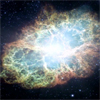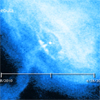Tour of the Crab
Quicktime MPEG
The Crab Nebula is one of the brightest sources of high-energy radiation in the sky. Little wonder - it's the expanding remains of an exploded star, a supernova seen in 1054. Scientists have used virtually every telescope at their disposal, including NASA's Chandra X-ray Observatory, to study the Crab. The supernova left behind a magnetized neutron star - a pulsar. It's about the size of Washington DC, but it spins 30 times a second. Each rotation sweeps a lighthouse-like beam past us, creating a pulse of electromagnetic energy detectable across the spectrum.
Here's what the sky looks like in high-energy gamma rays. The pulsar in the Crab Nebula is among the brightest sources. Recently, NASA's Fermi Gamma Ray Observatory and Italy's AGILE Satellite detected strong gamma-ray flares from the Crab, including a series of "superflares" in April 2011. To help pinpoint the location of these flares, astronomers enlisted Chandra.
With its keen X-ray eyes, Chandra saw lots of activity, but none of it seems correlated with the superflare. This hints that whatever is causing the flares is happening with about a third of a light year from the pulsar. And rapid changes in the rise and fall of gamma rays imply that the emission region is very small, comparable in size to our Solar System.
The Chandra observations will likely help scientists to home in on an explanation of the gamma-ray flares one day. The Chandra data provide strong constraints on the behavior, at relatively low energies, of the particles that have been accelerated to produce the gamma-ray flares. Even after a thousand years, the heart of this shattered star still offers scientists glimpses of staggering energies and cutting edge science.
[Runtime: 02:14]
Quicktime MPEG
The Crab Nebula is one of the brightest sources of high-energy radiation in the sky. Little wonder - it's the expanding remains of an exploded star, a supernova seen in 1054. Scientists have used virtually every telescope at their disposal, including NASA's Chandra X-ray Observatory, to study the Crab. The supernova left behind a magnetized neutron star - a pulsar. It's about the size of Washington DC, but it spins 30 times a second. Each rotation sweeps a lighthouse-like beam past us, creating a pulse of electromagnetic energy detectable across the spectrum.
Here's what the sky looks like in high-energy gamma rays. The pulsar in the Crab Nebula is among the brightest sources. Recently, NASA's Fermi Gamma Ray Observatory and Italy's AGILE Satellite detected strong gamma-ray flares from the Crab, including a series of "superflares" in April 2011. To help pinpoint the location of these flares, astronomers enlisted Chandra.
With its keen X-ray eyes, Chandra saw lots of activity, but none of it seems correlated with the superflare. This hints that whatever is causing the flares is happening with about a third of a light year from the pulsar. And rapid changes in the rise and fall of gamma rays imply that the emission region is very small, comparable in size to our Solar System.
The Chandra observations will likely help scientists to home in on an explanation of the gamma-ray flares one day. The Chandra data provide strong constraints on the behavior, at relatively low energies, of the particles that have been accelerated to produce the gamma-ray flares. Even after a thousand years, the heart of this shattered star still offers scientists glimpses of staggering energies and cutting edge science.
[Runtime: 02:14]
(Credit: NASA/CXC/MSFC/M.Weisskopf et al & A.Hobart)
Chandra Motion Sequence of Crab Nebula
Quicktime MPEG
A new movie from NASA's Chandra X-ray Observatory shows a sequence of Chandra images of the Crab Nebula, taken over an interval of seven months. Dramatic variations are seen, including the expansion of a ring of X-ray emission around the pulsar (white dot near center) and changes in the knots within this ring. Chandra began observing the Crab on monthly intervals beginning six days after the discovery of the gamma-ray flare in September 2010. This established a baseline of seven images of the nebula before the superflare was seen just last month. When scientists saw that more flaring activity was beginning in April 2011, a pre-planned set of five Chandra observations was initiated. Two of these observations were made when strong gamma-ray flares occurred, but no clear evidence was seen for correlated flares in the Chandra images. The movie shows the April observations in "slow motion" to focus on the time when the gamma-ray superflares occurred. The movie shows three loops through the sequence of images, along with a timeline near the bottom.
View Stills
[Runtime: 00:12]
Quicktime MPEG
A new movie from NASA's Chandra X-ray Observatory shows a sequence of Chandra images of the Crab Nebula, taken over an interval of seven months. Dramatic variations are seen, including the expansion of a ring of X-ray emission around the pulsar (white dot near center) and changes in the knots within this ring. Chandra began observing the Crab on monthly intervals beginning six days after the discovery of the gamma-ray flare in September 2010. This established a baseline of seven images of the nebula before the superflare was seen just last month. When scientists saw that more flaring activity was beginning in April 2011, a pre-planned set of five Chandra observations was initiated. Two of these observations were made when strong gamma-ray flares occurred, but no clear evidence was seen for correlated flares in the Chandra images. The movie shows the April observations in "slow motion" to focus on the time when the gamma-ray superflares occurred. The movie shows three loops through the sequence of images, along with a timeline near the bottom.
View Stills
[Runtime: 00:12]
(Credit: NASA/CXC/MSFC/M.Weisskopf et al & A.Hobart)
Return to Crab Nebula (May 11, 2011)




